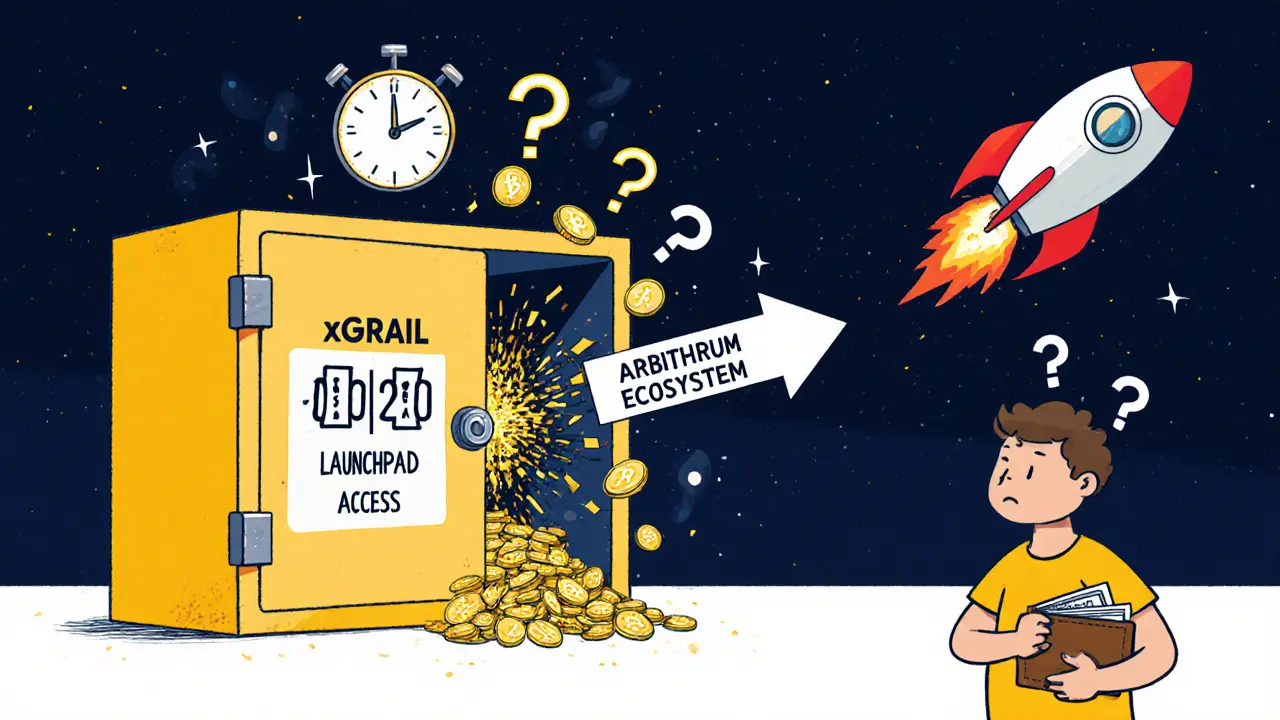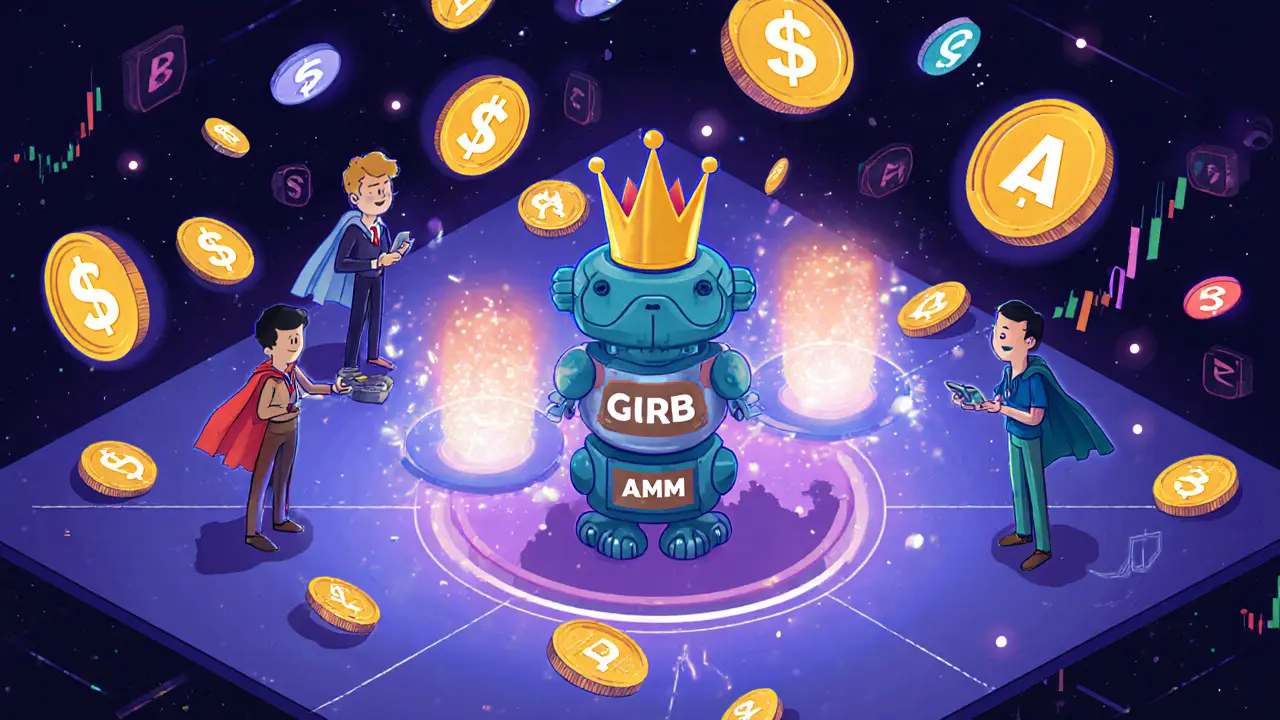Liquidity Provider Rewards Calculator
How Camelot V3 Rewards Liquidity Providers
Unlike traditional DEXs, Camelot V3 uses concentrated liquidity to maximize your returns. By locking your tokens in a specific price range, you can earn more rewards than spreading funds across the entire range.
Key Features: Zero trading fees, dual AMM system (separate pools for tokens and stablecoins), and $GRAIL rewards for liquidity providers.
Important Risk Notice: Your liquidity stops earning fees if the price moves outside your selected range. Monitor price movements carefully or use risk management tools.
Most crypto exchanges try to be everything to everyone - supporting dozens of blockchains, chasing volume across chains, and flooding users with confusing options. But Camelot V3 does the opposite. It doesn’t care about Bitcoin or Solana. It’s built for one thing: making Arbitrum better. If you’re trading on Arbitrum, this exchange might be the most efficient tool you haven’t tried yet.
What Is Camelot V3?
Camelot V3 is a decentralized exchange (DEX) built entirely on Arbitrum, one of the most popular Ethereum Layer 2 networks. Launched in late 2023, it’s not just another copy of Uniswap. It’s a purpose-built platform designed to solve real problems faced by Arbitrum-based projects and traders.
Unlike cross-chain DEXes that spread themselves thin, Camelot focuses all its energy on Arbitrum. That means faster trades, lower gas fees, and deeper liquidity for tokens native to the ecosystem. It supports 84 tokens and 109 trading pairs - enough to cover most DeFi projects on Arbitrum without cluttering the interface.
The core innovation? A dual AMM (Automated Market Maker) system. One pool handles regular tokens like $ARB and $WETH. The other is optimized for stablecoins like $USDC and $DAI. This separation lets Camelot apply different rules to each - like dynamic directional fees that change based on whether you’re buying or selling.
Zero Fees? How Does That Work?
Camelot V3 charges 0.00% maker fees and 0.00% taker fees. That’s not a typo. You pay nothing to trade.
So how does it make money? The answer lies in its token economy. The platform’s native token, $GRAIL, is the engine behind everything. Liquidity providers earn $GRAIL as rewards. Projects that want to list their tokens on Camelot often buy and lock up $GRAIL to boost visibility. The protocol also takes a small portion of trading rewards from yield farms and redirects them into the treasury, which funds development and marketing.
This model removes friction for traders but creates strong incentives for projects to stay loyal. Unlike other DEXes where liquidity flees the moment another chain offers higher APRs, Camelot rewards long-term commitment. That’s why its top pair, $USDC/$WETH, trades over $51 million daily - users know the liquidity won’t vanish overnight.
How Does Concentrated Liquidity Help You?
Camelot V3 uses Uniswap V3’s concentrated liquidity model - but improves it. Instead of spreading your funds across a wide price range (like 0.50 to 2.00 ETH), you can lock your capital in a narrow band - say, 1.80 to 1.95 ETH. That means your money works harder. You earn more fees per dollar invested.
For experienced traders, this is a game-changer. You can set custom ranges around support and resistance levels, mimicking how market makers operate on centralized exchanges. But here’s the catch: if the price moves outside your range, your funds stop earning fees until it comes back.
That’s why Camelot’s interface includes tools to visualize optimal ranges. You don’t need to guess where prices will swing. The platform shows historical volatility and projected movement zones. Still, if you’re new to DeFi, this feature can feel overwhelming. It’s not beginner-friendly by default - you need to learn how to use it.

GRAIL and xGRAIL: The Token Engine
Camelot runs on two tokens: $GRAIL and $xGRAIL.
$GRAIL is the main token. You earn it by providing liquidity. You can stake it to earn more. You can use it to vote on governance proposals. It’s the lifeblood of the platform.
$xGRAIL is what happens when you lock up $GRAIL. Locking your $GRAIL for up to four years gives you $xGRAIL - a boosted version that unlocks three key perks:
- Higher farming rewards (up to 2x more $GRAIL per day)
- Early access to new token launches on Camelot’s launchpad
- Reduced slippage on large trades
This system encourages long-term holding. If you’re just flipping tokens, you won’t care. But if you’re building a position in Arbitrum DeFi, locking $GRAIL can seriously boost your returns. Some users report earning 15-20% APY just from staking and farming combined - not counting token price gains.
How Does It Compare to Uniswap and SushiSwap?
Let’s be clear: Camelot V3 doesn’t beat Uniswap on volume. Uniswap trades over $2 billion daily. Camelot does $87 million. But that’s not the point.
Here’s how they stack up:
| Feature | Camelot V3 | Uniswap V3 | SushiSwap |
|---|---|---|---|
| Network | Arbitrum only | Multi-chain (Ethereum, BSC, Polygon, etc.) | Multi-chain |
| Trading Fees | 0.00% | 0.05%-0.30% | 0.20% |
| Liquidity Model | Dual AMM + Concentrated | Concentrated only | Concentrated only |
| Native Token | $GRAIL / $xGRAIL | $UNI | $SUSHI |
| Best For | Arbitrum users, long-term liquidity providers | General crypto traders | Yield farmers, multi-chain users |
Camelot wins on fees and ecosystem focus. Uniswap wins on liquidity depth and brand recognition. If you’re trading $ARB, $SPELL, or $GMX on Arbitrum, Camelot gives you better rates and higher rewards. If you’re swapping $ETH for $BTC, stick with Uniswap.

Who Should Use Camelot V3?
Camelot V3 isn’t for everyone. It’s not a wallet. It’s not a bridge. It’s not a place to buy your first $10 of crypto.
It’s perfect for three types of users:
- Arbitrum-native traders - If you’re already using Arbitrum for DeFi, this is your natural home. Lower fees, deeper pools, and better rewards make it the obvious choice.
- Liquidity providers - If you’re supplying $USDC/$WETH or $ARB/$GRAIL pairs, you’ll earn more here than on most other DEXes. The dual AMM and concentrated liquidity mean you get paid more for the same capital.
- Long-term $GRAIL holders - If you believe in Arbitrum’s future, locking $GRAIL gives you a stake in its growth. The boosted yields and launchpad access make it a strategic hold.
It’s not for you if:
- You trade across multiple chains daily
- You want regulatory protection or insurance
- You’re uncomfortable with smart contract risk
The Risks You Can’t Ignore
There’s no SEC oversight. No FDIC insurance. No customer support line. That’s the nature of DeFi - but Camelot makes it sharper.
First, it’s locked to Arbitrum. If Arbitrum’s traffic drops - say, because Starknet or zkSync gains more adoption - Camelot’s volume will fall with it. There’s no backup plan.
Second, $GRAIL’s price is volatile. Some analysts predict it could hit $200 by end of 2025. Others say it’s overvalued and could drop below $50. There’s no consensus. You’re betting on a token tied to a single ecosystem’s success.
Third, the interface is clean, but not intuitive. If you’ve never used concentrated liquidity before, you might accidentally lock your funds in a range that’s too narrow. One wrong move, and your liquidity stops earning fees for days.
And while the platform reports 70,800 monthly visits, the average user spends just over a minute on the site. That’s not a sign of delight - it’s a sign of efficiency. People come in, swap, farm, and leave. There’s no community, no forums, no tutorials. You’re on your own.
Final Verdict: Worth It?
Camelot V3 isn’t the biggest DEX. It’s not the most famous. But if you’re active on Arbitrum, it’s the smartest one to use.
Zero fees? Check. Better rewards than most? Check. Deep liquidity for top Arbitrum tokens? Check. A token economy that actually rewards loyalty? Big check.
The trade-off? You’re betting on one chain, one token, and one team. No safety net. No regulation. No hand-holding.
For experienced DeFi users who understand risk, that’s not a flaw - it’s the point. Camelot V3 isn’t trying to attract beginners. It’s trying to build the most efficient trading and liquidity engine for Arbitrum’s core community. And right now, it’s winning.
If you’re already on Arbitrum, try it. Start with a small trade. See how the fees stack up. Then try adding liquidity to a pair you already hold. You might find you’re earning more than you thought.
Just don’t expect a customer service rep to fix your mistake. That’s the price of freedom.
Is Camelot V3 safe to use?
Camelot V3 is a decentralized exchange, meaning it runs on smart contracts - not a company. There’s no central authority to freeze your funds or reverse trades. That’s both a strength and a risk. The code has been audited by reputable firms, but no audit eliminates all risk. If you use it, assume you’re responsible for your own security. Never invest more than you’re willing to lose.
Do I need ETH to use Camelot V3?
You don’t need ETH directly, but you do need ARB or WETH to pay for gas on Arbitrum. Arbitrum uses ETH as its base currency for transaction fees. You’ll need a small amount of ETH (or wrapped ETH) in your wallet to cover gas when swapping or adding liquidity. Most users keep 0.01-0.02 ETH on hand for this purpose.
Can I stake $GRAIL without locking it?
Yes. You can stake $GRAIL directly in the staking pool without locking it. This gives you standard farming rewards. But if you lock your $GRAIL for 1-4 years, you get $xGRAIL, which boosts your rewards by up to 2x and unlocks early access to new token launches. Locking is optional, but the rewards are significantly higher.
What’s the best trading pair on Camelot V3?
The most liquid and actively traded pair is $USDC/$WETH. It accounts for nearly 60% of Camelot’s total daily volume. This pair has the tightest spreads, lowest slippage, and highest rewards for liquidity providers. If you’re new to the platform, start here.
How do I get $GRAIL tokens?
You can earn $GRAIL by providing liquidity to trading pairs on Camelot V3. For example, depositing $USDC and $WETH into a liquidity pool will reward you with $GRAIL over time. You can also buy $GRAIL directly on the exchange using other tokens like $USDC or $ARB. It’s not listed on major centralized exchanges like Binance or Coinbase, so you’ll need to trade it on Camelot or another DEX that supports Arbitrum.
Is Camelot V3 better than Uniswap for Arbitrum users?
For Arbitrum-native users, yes - especially if you’re providing liquidity or trading frequently. Camelot offers zero trading fees, higher rewards for liquidity providers, and a more tailored interface for Arbitrum tokens. Uniswap has more volume and broader token support, but you pay 0.05%-0.30% in fees and get lower rewards. If you’re serious about Arbitrum, Camelot is the smarter tool.

Camelot V3 is the only DEX on Arbitrum that actually makes sense for liquidity providers. Zero fees? Yeah, that’s wild. But the $GRAIL tokenomics are what really lock you in. You’re not just trading-you’re investing in the ecosystem’s backbone. Most DEXes treat LPs like disposable income sources. Camelot treats them like co-owners.
i tried it yesterday and my trade took 3 seconds and cost 0.0001 eth… i thought my wallet was broken
Let’s be real-this is just another ‘Arbitrum-only’ vanity project. You think zero fees means you’re winning? You’re just subsidizing the whales who front-run your trades with their xGRAIL boosts. And don’t get me started on the slippage traps for newbies who don’t know how to set ranges. This isn’t innovation-it’s predatory efficiency disguised as DeFi utopia. If you’re not already deep in Arbitrum, stay the hell away.
if you trade on arbitrum you have no choice but to use camelot the fees are too low to ignore and the rewards are real
Just added $USDC/WETH liquidity for the first time. Earned 12% APY in 10 days without even trying. This is what DeFi was supposed to feel like. No drama, no noise, just clean math. Thanks for the write-up, it actually helped me get started.
Camelot is just a Trojan horse for the Arbitrum oligarchy. They’re not building for users-they’re building for venture capital that already owns 60% of $GRAIL. The ‘zero fees’? It’s a bait. You pay in opportunity cost, governance dilution, and emotional labor trying to understand why your liquidity vanished because you set your range 0.05% too wide. This isn’t freedom. It’s algorithmic feudalism.
why is everyone acting like this is new
NEW TO ARBITRUM? START HERE: 💡 1. Get 0.01 ETH in your wallet (for gas). 💡 2. Go to camelot.finance. 💡 3. Pick USDC/WETH pair. 💡 4. Add $100 liquidity. 💡 5. Stake your GRAIL → boom, you're earning! 🚀 No stress, no confusion. You got this!!
you people are so naive the entire GRAIL token is pump and dump wrapped in a whitepaper and the devs are just waiting for retail to lock up their funds so they can exit liquidity. you think the 2x rewards are real? they’re just front-running your deposits with their own private pools
if you’re not using concentrated liquidity on camelot you’re literally leaving free money on the table. i’ve seen people earn 3x more than they would on uniswap just by setting ranges around recent price swings. it’s not magic, it’s math. learn it or get left behind
just locked 500 GRAIL for 2 years. got my xGRAIL and now i’m in the next token launch queue. this is the future of DeFi. no cap.
As a financial technologist with over a decade of experience in decentralized systems, I must emphasize: while Camelot V3’s dual-AMM architecture is theoretically elegant, the absence of formal insurance mechanisms, coupled with the concentration of governance power in long-term xGRAIL holders, creates a non-transparent power hierarchy. This is not decentralization-it is stratified governance masked as innovation.
lol i spent 20 mins trying to add liquidity and accidentally set my range from 1.8 to 1.81 eth… my funds are now sitting there like a statue. i feel like i just bought a digital painting that only moves when the price does. thanks camelot. 🤡
70k monthly visits and average time on site is 60 seconds? That’s not efficiency. That’s a ghost town with a fancy UI. No community, no support, no feedback loops. This isn’t a platform-it’s a terminal.
who owns the arbitrum chain anyway? do you really think the devs of camelot are independent? check the github commits before 2023. same wallets as the arbitrum foundation. this is a controlled environment. you think you’re trading freely? you’re in a walled garden with a price tag
What is the exact formula for calculating the dynamic directional fees in Camelot’s stablecoin pool? Are they based on order flow imbalance, time-weighted average price deviation, or a proprietary heuristic? The whitepaper is vague on implementation details.
is the real win here not the fees or the rewards… but the fact that you’re not competing with 10,000 bots trying to front-run you on ethereum? on arbitrum, the game feels… human. like you’re actually part of something small and real. that’s rare.